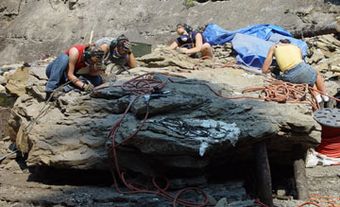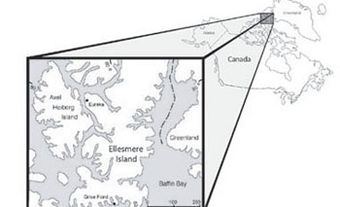Hilda Dinosaur Mega-Bonebed, Alberta
The Hilda mega-bonebed in southern Alberta is one of the largest dinosaur bonebeds in the world and the largest in Canada. It is made up of a group of at least 14 discontinuous bonebeds that occur in a mudstone deposit exposed along the South Saskatchewan River west of Hilda. It is estimated that the mega-bonebed contains the remains of a few thousand individuals of the cow-size dinosaur, Centrosaurus apertus. Although the mega-bonebed covers an area of at least 2.3 square kilometres on either side of the South Saskatchewan River valley, the discontinuous bonebeds that make up the mega-bonebed cover only hundreds to a few thousands of square metres each.
The site is important because it confirms that Centrosaurus was a herding dinosaur, and documents that the herds were larger than previously thought, numbering well into the thousands. When combined with data from Dinosaur Provincial Park, located 100 km west of Hilda, data from the mega-bonebed also suggest that Centrosaurus migrated annually in an east-west direction, toward or away from the interior seaway that occupied the centre of North America at that time.
The Site
The Hilda area was selected for study by the Royal Tyrrell Museum scientists in 1997 because of the potential it offered to better understand the size of ceratopsian herds. Although there had been considerable study of Centrosaurus bonebeds at Dinosaur Provincial Park since the late 1970s, the three-dimensional Badlands at the Park made it difficult to test the hypothesis that some of those bonebeds may have been deposited together as part of a larger event. The more continuous geologic exposures along the steeply walled South Saskatchewan River valley west of Hilda allowed higher resolution stratigraphic correlation of fossil localities.
Based on the field notes of Wann Langston (1959) and excavation reports from the Provincial Museum (1964-1966), two Centrosaurus bonebed sites were already known from the Hilda area. However, during a two-day reconnaissance by the Tyrrell Museum in 1997, a total of 14 Centrosaurus bonebeds were documented in one geologic horizon, thus confirming the presence of the mega-bonebed and defining its minimum extent.
The mega-bonebed occurs in the lower 25 metres of the Dinosaur Park Formation, a world-renowned geological unit that is rich in dinosaurs and well exposed at Dinosaur Provincial Park. The age of the bonebed has been assessed at 76 million years, the same age as the lower portion of the rich dinosaur assemblage at Dinosaur Provincial Park.
The Tyrrell Museum excavated and studied parts of the Hilda mega-bonebed in 1997. That research indicated that the Hilda mega-bonebed is a monodominant bonebed that contains the skeletal remains of mostly one species of horned dinosaur, Centrosaurus apertus.
Origin and Significance of the Hilda Mega-Bonebed
Like many of the monodominant bonebeds at Dinosaur Provincial Park, the Hilda mega-bonebed appears to have resulted from a large-scale coastal plain flood that overtook a very large herd of Centrosaurus apertus. Evidence for coastal plain flooding recurs throughout the Cretaceous formations that host these bonebeds. Large-scale flooding appears to have been driven by seasonally active tropical storms in the adjacent seaway. Accordingly, such storms were probably similar to those that occur today in coastal regions of the Gulf of Mexico and Bangladesh. Data from the fossils collected at Hilda indicate that death and final burial were caused by separate flooding events. For example, many of the ceratopsian carcasses at Hilda were trampled, broken and scavenged by other dinosaurs before final burial.
Monodominant bonebeds containing the remains of horned dinosaurs such as Centrosaurus, Styracosaurus, and Pachyrhinosaurus are common in upper Cretaceous sediments at many localities throughout southern and central Alberta. For example, seventeen Centrosaurus bonebeds and two Styracosaurus bonebeds have been documented so far at Dinosaur Provincial Park, although there is no direct evidence that any of these form a mega-bonebed. Multiple occurrences of monodominant bonebeds containing the same kind of dinosaur are regarded as strong evidence for normal, gregarious behaviour. Thus, the Hilda mega-bonebed provides additional evidence that herding behaviour was normal for Centrosaurus apertus, and that herds of Centrosaurus moved regularly in an east-west direction between Hilda and Dinosaur Provincial Park.
Whether or not the Hilda mega-bonebed is actually the biggest bonebed in the world is an academic question that cannot be answered easily. The site is remote and difficult to work, and the effort, complexity and resources required to fully unearth the site would be staggering. At present, the Zhucheng bonebed in Shandong, China, holds the record as the world's largest and continuously traceable dinosaur bonebed. As currently excavated it is 500 m long and 30 m wide, and comprises multiple beds of fossil-rich sediment that host tens of thousands of elements from the giant (~20 tonnes) hadrosaur Shantungosaurus giganteus.
See also Dinosaur Hunting in Western Canada; British Columbia Dinosaur Excavations.

 Share on Facebook
Share on Facebook Share on X
Share on X Share by Email
Share by Email Share on Google Classroom
Share on Google Classroom





